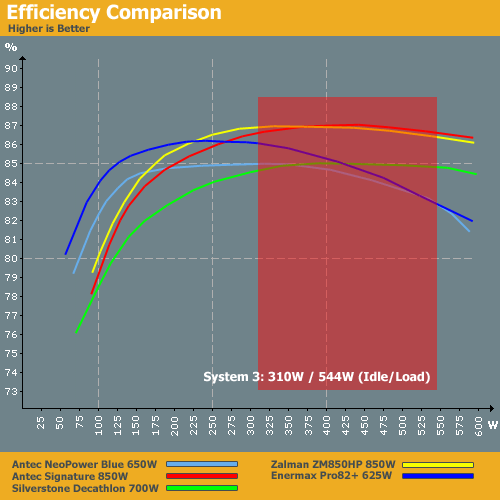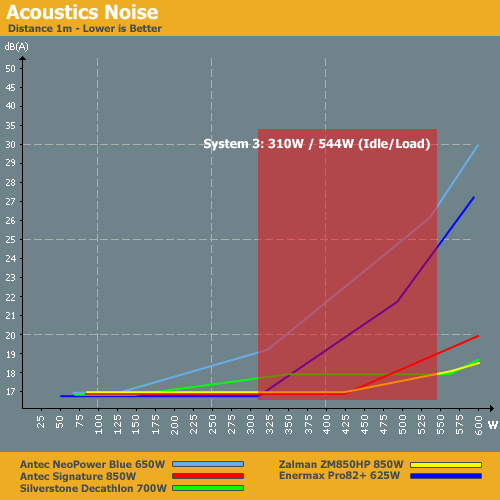Debunking Power Supply Myths
by Christoph Katzer on September 22, 2008 3:00 AM EST- Posted in
- Cases/Cooling/PSUs
PSUs for High-End Systems
Even though our high-end system consumes more power, we used the same graph layout. That means the resulting graphs stop at 600W, despite the high-end PSUs all being capable of providing more power than that. Our high-end system sports an SLI setup using two NVIDIA 8800 ultra cards; 3-way SLI would be a bit more demanding, but we don't feel it's a good indication of what people are actually running. The third card would also only add another 50W to 90W of power consumption to our system, since the third card is rarely taxed as much as the first GPU.
- Antec NeoPower Blue (650W) actively cooled
- Antec Signature (850W) actively cooled
- Silverstone Decathlon (700W) actively cooled
- Zalman ZM850HP (850W) actively cooled
- Enermax Pro82+ (625W) actively cooled

We've included the Enermax Pro82+ 625W from the midrange selection as well. Again, efficiency is not the major issue when it comes to choosing between these products. The two lowest rated power supplies -- Antec NeoPower 650W and Enermax Pro82+ 625W -- are less efficient over the tested range, but that's expected. The results all of her around 85% to 87% mark, and one or 2% difference really isn't going to matter much. Still, the Zalman and Antec 850W units place at the top of this chart.

Again, the two power supplies with the lowest output rating perform worse in this test, generating much more noise than the competition. The higher rated units don't have to work as hard, since they are running at a medium load. Those three PSUs remain very quiet along with providing better efficiency, making them the better for a high-end setup. The Zalman and Antec Signature 850W units would be our choice, if only for the extra headroom. Either PSU would have no difficulty with a 3-way GPU setup, provided you have sufficient PEG connections available. That brings up the next topic of discussion.










98 Comments
View All Comments
Dancer - Thursday, October 22, 2009 - link
On the face of it, this article seems an excellent, well-researched contribution to a highly vexed question. I do have a concern, however: We know that the power output of a PSU drops as it ages. We also know that this drop depends partly on quality and partly due to random chance. If I'm buying a PSU to last 3, 5 or more years, will this seriously affect the capacity of the PSU I should buy for a given machine?internetrush - Saturday, June 6, 2009 - link
Ok, lets low ball it, im running 200w (average) per graphics card, about 50w cpu (core i7) and three hard drives.Lets see
200 x 2
+50 + 50 (motherboard chipset)
+30 Sound card
+10 cd drive
+20 (fans)
During a game, much less a stress test, im lowballing a 600w load on my PSU.
If i had an 800w PSU that would be 80% of its total output, which thereby increases its heat and decreases its life.
When you buy a 1000w PSU, not only are you ensuring that you will never watch your computer go up in smoke (had a friend do that to a 350w on an old P4) but you are also not having to replace it whenever you buy a new processor or add something to your system.
This article is good, however, on a tech website i would expect a bit more consideration for the higher end gamers and common sense.
Common sense says, if you are a higher end system user, you WILL expand said system!
For gods sake! Some cards today use up to 500w power (the 4890X2 and new 295 SuperCard).
As a gamer, id rather have a 2000W PSU that id never have to replace than a 400w that would FRY as soon as i threw on a new video card.
Christoph Katzer - Saturday, August 8, 2009 - link
Sorry for the late reply.You are probably right when you see it from the perspective of a high-end-hardcore-gamer... But do you know how small the percentage of people is who actually own a real high-end system?
JohnMD1022 - Sunday, March 15, 2009 - link
It would be nice if you could periodically update this with newer components.lopri - Tuesday, April 28, 2009 - link
BillyBuerger - Sunday, October 26, 2008 - link
Anyone have any info on that Thermaltake QFan 300? That thing looks great efficiency wise. Not normally a Thermaltake fan. And the fan controller looks like it sucks. Just keep it below 150W... Or fan swap.Christoph Katzer - Thursday, October 30, 2008 - link
I will have a review up soon!Cincybeck - Tuesday, September 30, 2008 - link
Couple of "knowitall" friends were trying to tell me I was going to need a larger power supply when I built my new system. Which in turned incited the Microcenter sales person saying oh yea you're probably going to need that too. I turned around said I estimated these parts to draw at most around 200, 250 watts, and I have a 500W Seasonic M12. Shut him up pretty quickly, but my friends were still pushing it the whole way home. So now if they ever bring it up again I can print this article and shove it in their face. Thanks =D0roo0roo - Sunday, September 28, 2008 - link
i like the graphs:)keep it up!
this is the info we need!
normally the psu market is just lousy because of the lack of any real information.
mark84 - Friday, September 26, 2008 - link
For those quoting that old link for the AtomicMPC graphics card power thread, the new/current one is being maintained here http://forums.atomicmpc.com.au/index.php?showtopic...">http://forums.atomicmpc.com.au/index.php?showtopic...